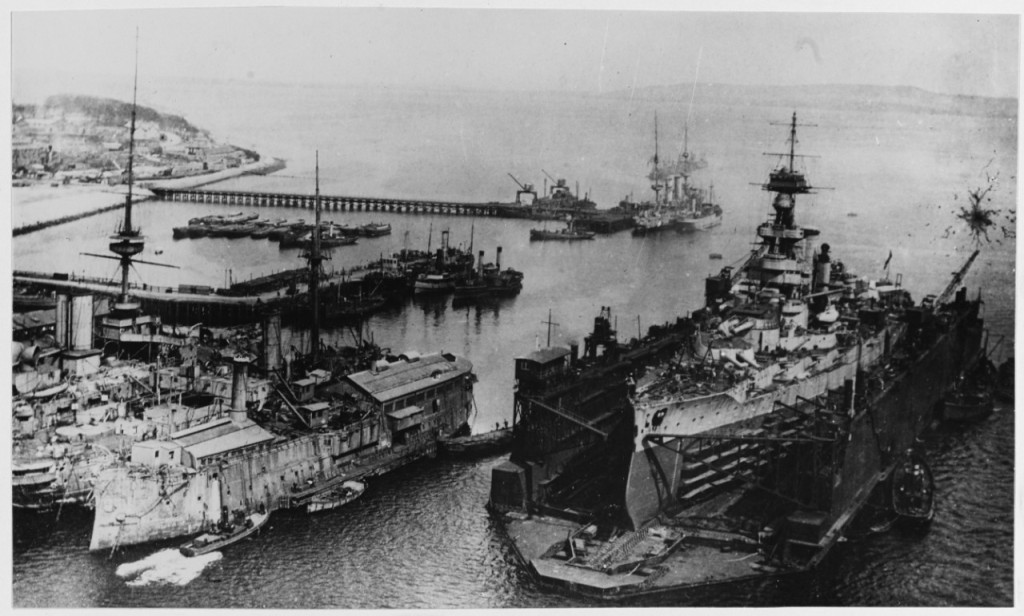
Photograph: Naval History and Heritage Command NH 41762.
In Aidan Dodson’s new book on The Windfall Battleships he refers (page 23) to the battleship Erin:
Fuel stowage was, however, only two-thirds that of her British contemporaries, and difficult to access. As CinC Grand Fleet remarked to DNC:
The Erin is I fear going to be a trouble to me. She only has 1000 tons of coal that is available for steaming. The rest is athwart Engine Rooms & can’t be trimmed forward for real steaming. The nominal 2000 tons is a fraud. I am telling her to use oil whenever possible to help the coal out.
The source given is a letter of 19 September 1914 from Admiral Sir John Jellicoe in d’Eyncourt’s papers at the National Maritime Museum. The word ‘athwart’ is more likely ‘abreast’. Dodson leaves it at that, which is a shame, as it would be interesting to know if the Ship’s Covers at Woolwich provide more information on Erin‘s bunkerage. However, elsewhere in d’Eyncourt’s papers (I’m not saying where, this isn’t a research charity) is a 28 September minute from W. H. Gard, one of the Assistant Directors of Naval Construction:

d’Eyncourt embodied this in his reply to Jellicoe on 29 September, which he also showed to Rear-Admiral Frederick Tudor, the Third Sea Lord:

Lesson to be learned? There are always two sides to a story.
Thanks for this additional info.
I was hoping that this book might address the reports of Agincourt’s shells braking up in flight (mentioned by Richard Hough in “The Great Battleship”), but I did not find anything.
NCC1717
LikeLike
I can’t say it’s something I’ve ever come across.
LikeLike
Another technical issue of particular interest to me that is raised in The Windfall Battleships is the speed of Canada. On page 32 it states that during trials the seals of her high pressure turbines were damaged and not repaired, limiting her speed “henceforth” to 21 knots. This does not seem to have been known by the fleet commander, since his letter to Sir Henry Jackson on 5 March 1916 says Canada and Agincourt “are nearly as fast as the Fifth Battle Squadron…” (see The Jellicoe Papers, Vol. I, No. 204, page 225).
LikeLike
According to D.N.C.’s history of wartime construction Canada never did formal speed trials, but “during her run to the Base [Scapa Flow] the machinery maintained a collective H.P. of 52,700 S.H.P. for two hours, corresponding to an estimated speed of just over 24 knots”. Of course maybe something went wrong but Rear-Admiral Duff (the divisional commander) never mentioned it in his diary.
LikeLiked by 1 person
I have this from two other books:
Friedman “The British Battleship”, page 168, has this on the same trials:
“The British CO was unaware that the Chileans had required additional spare boilers, so on the ship’s run to Scapa Flow after commissioning he used all his boilers, generating 52,692 SHP (333.5 rpm); It was estimated that this would equate to 24.3 knots. 106”
Note 106 (page 387) says:
“Agincourt/Canada Cover, Folio 28 summaries trials dated 14-15 October 1915. The ship maintained this power for two hours. For one hour she maintained 43,850 SHP/310 revs and for one hour 39,247 SHP/305 revs (equivalent to 22.7 knots). Displacement was not stated. These figures are dated 16 May 1918. The official DNC history of warship construction equated the 52,692 SHP performance to 21.5 knots. Presumably the actual speed was somewhat embarrassing, as is exceed (sic) that of the Queen Elizabeths.”
Burt, “British Battleships of World War One (New Revised Edition), page 263 has this paragraph:
CANADA: STEAM TRIALS
It being wartime, no speed trials were conducted. The following figures were recorded at sea on 16 May 1918.
303rpm 38,427shp 22.7 knots
310rpm 43,850shp not recorded
335.5rpm 52,682shp 24.3 knots
Note the slight differences in the numbers:
Friedman : Burt
52,692 : 52,682
333.5 : 335.5
39,247 : 38,427
LikeLike
It seems as if several authors looked at the same sources and came away with different data and interpretations. Friedman’s citations don’t contradict Dodson, even though he doesn’t mention damage. Burt’s citation implies that the ship was significantly faster than her design speed in 1918.
Dodson has additional references to the damage to the turbines are on pages 208, 227 and 232.
{Sorry for the two replies. This system is not allowing me to finish writing before posting}
LikeLike
Typo on my part: Burt has 38,247 shp, not 38,427.
LikeLike
The ‘official DNC history of warship construction’ Friedman refers to clearly says ‘over 24 knots’ – the 4 for some reason is faint, but still legible (I checked a friend’s photos of the copy to check). He really needs to read the stuff he photographs properly. Therefore the “actual speed was somewhat embarrassing” line is conspiracy theory-level nonsense.
The difference in S.H.P. and R.P.M. between Burt and Friedman doesn’t surprise me in the slightest. The only problem is which is right? Both have form for poor transcription. Next time I’m in among the Ships’ Covers I may investigate this, and also the Agincourt stuff: I had a look at Hough the other day and if there’s anything to the story there must be copies in the cover she shares with Canada.
LikeLike
Thank you. I live a long way from any historical archives and appreciate that you take the time to do this kind of research.
LikeLike